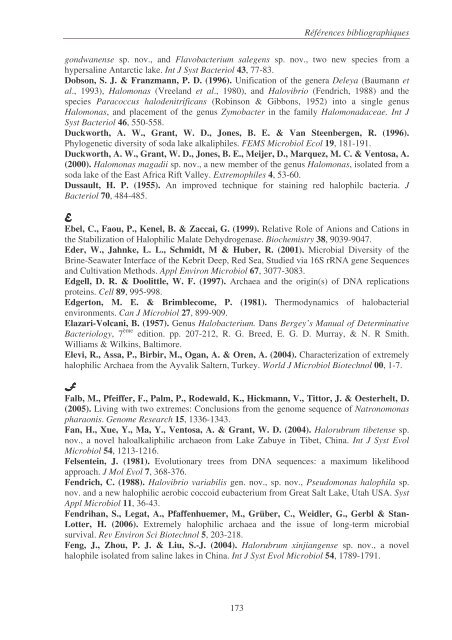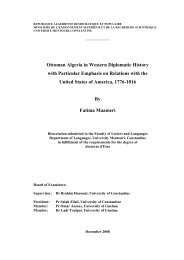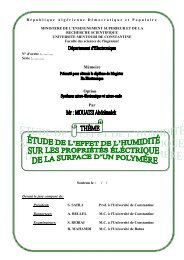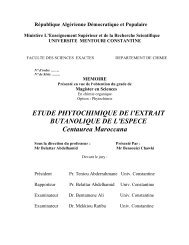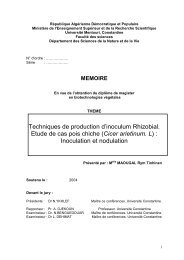(Thèse partie 1)
(Thèse partie 1)
(Thèse partie 1)
You also want an ePaper? Increase the reach of your titles
YUMPU automatically turns print PDFs into web optimized ePapers that Google loves.
173<br />
Références bibliographiques<br />
gondwanense sp. nov., and Flavobacterium salegens sp. nov., two new species from a<br />
hypersaline Antarctic lake. Int J Syst Bacteriol 43, 77-83.<br />
Dobson, S. J. & Franzmann, P. D. (1996). Unification of the genera Deleya (Baumann et<br />
al., 1993), Halomonas (Vreeland et al., 1980), and Halovibrio (Fendrich, 1988) and the<br />
species Paracoccus halodenitrificans (Robinson & Gibbons, 1952) into a single genus<br />
Halomonas, and placement of the genus Zymobacter in the family Halomonadaceae. Int J<br />
Syst Bacteriol 46, 550-558.<br />
Duckworth, A. W., Grant, W. D., Jones, B. E. & Van Steenbergen, R. (1996).<br />
Phylogenetic diversity of soda lake alkaliphiles. FEMS Microbiol Ecol 19, 181-191.<br />
Duckworth, A. W., Grant, W. D., Jones, B. E., Meijer, D., Marquez, M. C. & Ventosa, A.<br />
(2000). Halomonas magadii sp. nov., a new member of the genus Halomonas, isolated from a<br />
soda lake of the East Africa Rift Valley. Extremophiles 4, 53-60.<br />
Dussault, H. P. (1955). An improved technique for staining red halophilc bacteria. J<br />
Bacteriol 70, 484-485.<br />
Ebel, C., Faou, P., Kenel, B. & Zaccai, G. (1999). Relative Role of Anions and Cations in<br />
the Stabilization of Halophilic Malate Dehydrogenase. Biochemistry 38, 9039-9047.<br />
Eder, W., Jahnke, L. L., Schmidt, M & Huber, R. (2001). Microbial Diversity of the<br />
Brine-Seawater Interface of the Kebrit Deep, Red Sea, Studied via 16S rRNA gene Sequences<br />
and Cultivation Methods. Appl Environ Microbiol 67, 3077-3083.<br />
Edgell, D. R. & Doolittle, W. F. (1997). Archaea and the origin(s) of DNA replications<br />
proteins. Cell 89, 995-998.<br />
Edgerton, M. E. & Brimblecome, P. (1981). Thermodynamics of halobacterial<br />
environments. Can J Microbiol 27, 899-909.<br />
Elazari-Volcani, B. (1957). Genus Halobacterium. Dans Bergey’s Manual of Determinative<br />
Bacteriology, 7 ème edition. pp. 207-212, R. G. Breed, E. G. D. Murray, & N. R Smith.<br />
Williams & Wilkins, Baltimore.<br />
Elevi, R., Assa, P., Birbir, M., Ogan, A. & Oren, A. (2004). Characterization of extremely<br />
halophilic Archaea from the Ayvalik Saltern, Turkey. World J Microbiol Biotechnol 00, 1-7.<br />
Falb, M., Pfeiffer, F., Palm, P., Rodewald, K., Hickmann, V., Tittor, J. & Oesterhelt, D.<br />
(2005). Living with two extremes: Conclusions from the genome sequence of Natronomonas<br />
pharaonis. Genome Research 15, 1336-1343.<br />
Fan, H., Xue, Y., Ma, Y., Ventosa, A. & Grant, W. D. (2004). Halorubrum tibetense sp.<br />
nov., a novel haloalkaliphilic archaeon from Lake Zabuye in Tibet, China. Int J Syst Evol<br />
Microbiol 54, 1213-1216.<br />
Felsentein, J. (1981). Evolutionary trees from DNA sequences: a maximum likelihood<br />
approach. J Mol Evol 7, 368-376.<br />
Fendrich, C. (1988). Halovibrio variabilis gen. nov., sp. nov., Pseudomonas halophila sp.<br />
nov. and a new halophilic aerobic coccoid eubacterium from Great Salt Lake, Utah USA. Syst<br />
Appl Microbiol 11, 36-43.<br />
Fendrihan, S., Legat, A., Pfaffenhuemer, M., Grüber, C., Weidler, G., Gerbl & Stan-<br />
Lotter, H. (2006). Extremely halophilic archaea and the issue of long-term microbial<br />
survival. Rev Environ Sci Biotechnol 5, 203-218.<br />
Feng, J., Zhou, P. J. & Liu, S.-J. (2004). Halorubrum xinjiangense sp. nov., a novel<br />
halophile isolated from saline lakes in China. Int J Syst Evol Microbiol 54, 1789-1791.


